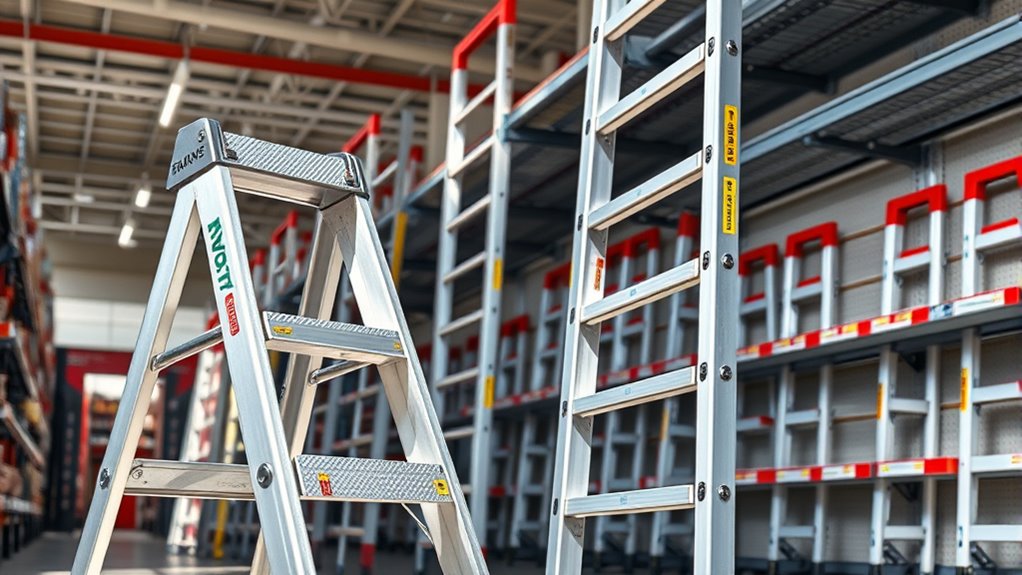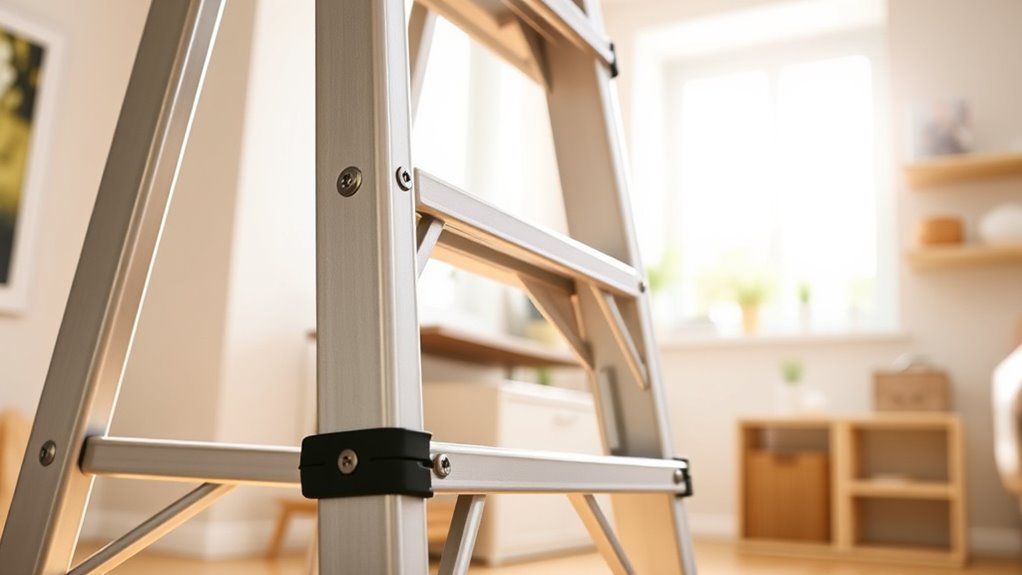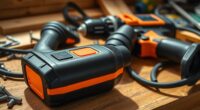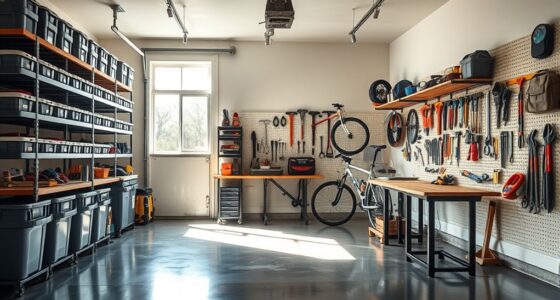To pick the right ladder for home use, consider what tasks you’ll do and where you’ll use it. For indoor jobs, choose a stable step ladder or multi-position ladder that’s lightweight and easy to move. For outdoor or higher tasks, an extension ladder or fiberglass option offers safety and reach. Keep safety features like non-slip feet and secure locking mechanisms in mind, and make sure the ladder supports your weight plus tools. If you stay with us, you’ll discover even more helpful tips.
Key Takeaways
- Determine the task height and choose a ladder that safely reaches without overextending.
- Assess whether indoor or outdoor use, and select the appropriate ladder type accordingly.
- Consider material options like aluminum for lightweight needs or fiberglass for electrical safety.
- Check safety features such as non-slip feet, locking mechanisms, and load capacity for stability.
- Match the ladder’s height and features to your specific project requirements for optimal safety and efficiency.

Choosing the right ladder is imperative to completing your tasks safely and efficiently. When you’re selecting a ladder for home use, you need to consider the type that best suits your specific projects. For indoor tasks like painting or changing light bulbs, a step ladder or a platform ladder usually works best. These ladders are self-supporting, stable, and provide a secure platform, making them ideal for tasks that require standing for a while. If you’re working outdoors or need to reach higher places, an extension ladder or a multi-position ladder can give you the extra height you need. Extension ladders are great for tall exterior walls or roofs, while multi-position ladders offer versatility because they can be adjusted into various configurations.
Choose the right ladder for safe, efficient home projects indoors and outdoors.
Safety features are critical when choosing a ladder. Look for ladders with high-duty ratings like Type 1AA, which can handle heavy loads, especially if you’ll be carrying tools or materials. Non-slip feet are essential to prevent slipping on different surfaces, and leveling feet help when you’re working on uneven ground. Secure locking mechanisms ensure the ladder stays in place during use, preventing accidents. Safety railings on some models add extra support, especially if you’ll be working at height for an extended period.
Material choice also affects your decision. Aluminum ladders are lightweight, making them easy to transport and set up, perfect for quick jobs around the house. Fiberglass ladders are more durable and provide electrical insulation, making them safer for working near power lines or electrical fixtures. Wooden ladders offer a traditional feel but tend to be heavier, so they’re better suited for stationary tasks. Some ladders include rubber feet for extra grip on smooth surfaces, reducing the risk of slipping.
When evaluating ladder height, consider the maximum reach you’ll need. Step ladders typically reach 10 to 16 feet, which suffices for most indoor chores. Multi-position ladders can extend up to 26 feet, suitable for taller exterior work. Extension ladders provide the greatest reach but require proper support and stability. Always match the ladder height to your task and your own height to guarantee safe and comfortable access.
Additionally, consider the load capacity of the ladder to ensure it can safely support your weight along with any tools or materials you’ll be carrying. Finally, think about any specialized features that could make your work easier. Telescoping ladders adjust to fit tight spaces, while twin step ladders allow two people to work simultaneously. Platform and podium ladders offer stable standing surfaces and larger work areas. Including storage trays or tool holders can help keep your tools within reach, saving time and effort.
Frequently Asked Questions
What Safety Features Should I Look for in a Ladder?
When selecting a ladder, you should look for essential safety features. Make certain it has non-slip feet to prevent slipping, and that rungs are securely attached for stability. Check for clear safety labels and guarantee it allows three-point contact during climbing. Avoid metal ladders near electrical sources and confirm it’s in good condition with no damage. These features help keep you safe while working at height.
How Do Weight Capacity Ratings Affect Ladder Selection?
Weight capacity ratings directly impact your ladder choice because they determine how much weight it can safely sustain, including your body and tools. You should select a ladder with a duty rating at or above your combined weight to ensure stability and safety. Using a ladder with too low a rating risks bending, swaying, or failure, while choosing one with a higher rating offers a safer, more durable option for your tasks.
Are There Specific Ladder Types for Indoor Versus Outdoor Use?
Isn’t it true that not all ladders are created equal? When choosing a ladder, you’ll find specific types suited for indoor and outdoor use. Indoor ladders, like step and folding ladders, prioritize stability, space efficiency, and safety features. Outdoor ladders, such as extension and fiberglass models, focus on durability, reach, and weather resistance. Picking the right one depends on where and what you need to do.
How Do I Maintain and Store My Ladder Properly?
To maintain and store your ladder properly, regularly inspect for damage, loose screws, or wear on rungs and side rails. Keep it clean and lubricate moving parts. Store it horizontally on a rack, protected from weather and direct sunlight. Secure during transport, and ensure the storage area is stable and free of obstacles. When disposing, cut the ladder in half or destroy it to prevent unauthorized use and ensure safety.
What Are the Latest Innovations in Ladder Technology?
They say, “Innovation is the ladder to progress.” Today’s ladders feature multi-position designs, allowing quick transformation between types. You’ll find smart stabilization tech, like electronic sensors and bubble levels, ensuring safety on uneven surfaces. Safety features such as non-slip steps and locking mechanisms boost your confidence. Plus, lightweight, foldable models with built-in tool trays make your tasks easier and more efficient. These innovations enhance safety, versatility, and convenience for your home projects.
Conclusion
Choosing the right ladder is like finding a trusted friend—you want one that’s reliable, safe, and suited to your needs. By considering your tasks, weight capacity, and the ladder’s features, you’ll guarantee your home projects go smoothly. Don’t rush the decision; a well-chosen ladder is an investment in your safety and confidence. Like a sturdy bridge over a stream, the right ladder will support you comfortably and securely, making every job feel a little easier.










